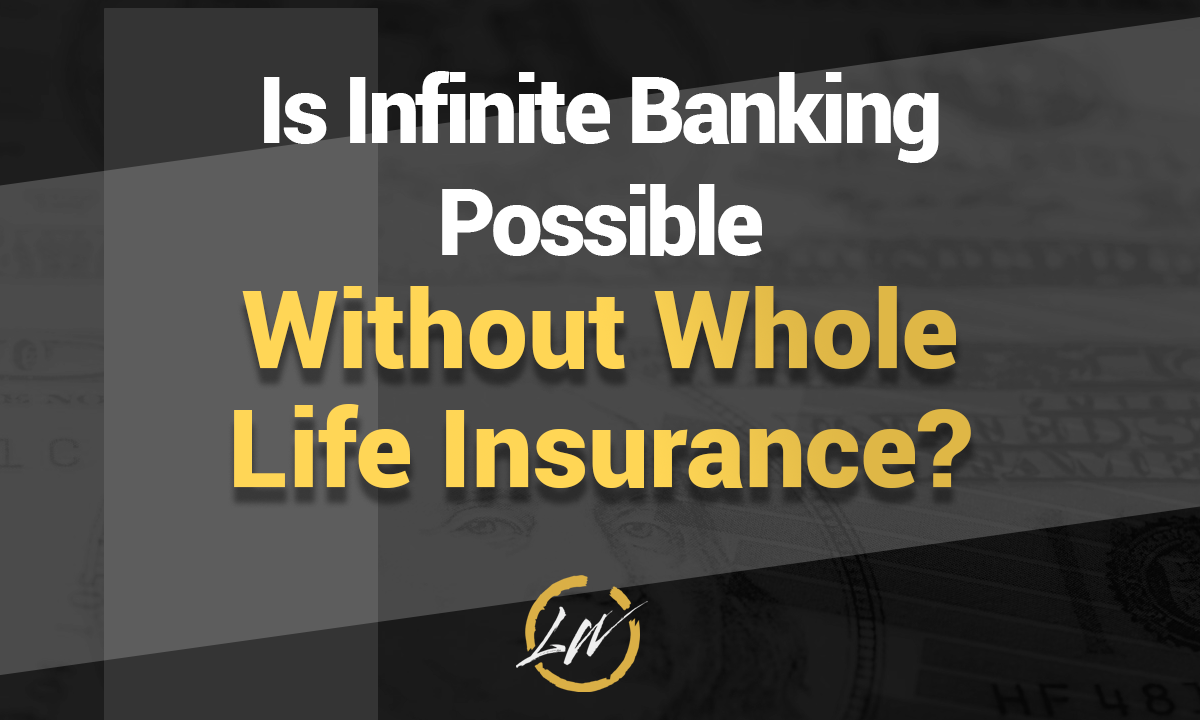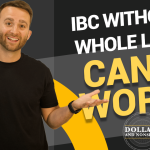Most people who are already interested in Infinite Banking ask us how to use whole life insurance to build wealth, but sometimes people just want a way to bank smarter without tying themselves to a whole life insurance policy. So if you’re one of them, this blog post is for you!
Today, we’re diving into the world of Infinite Banking and exploring whether it’s possible to achieve financial freedom and control without relying on traditional banking methods or whole life insurance, by taking a look at alternative financial strategies that offer banking functionality without the commitment to whole life insurance.
Exploring Alternative Banking Methods:
Before we dive in, if you want the full scope about this topic, we recommend listening to our latest Dollars and Nonsense episode about “Can You Practice IBC Without Whole Life Insurance?”
Now, you might be tired of the limitations of traditional banking or maybe you’ve been searching for ways to take control of your finances and maximize your returns. If so, you’re not alone.
Let’s face it, traditional banking has a lot of drawbacks. Savings accounts offer meager interest rates that often fail to keep pace with inflation. As a result, the purchasing power of your savings diminishes over time. Plus, conventional banks impose various fees and restrictions, limiting your control over your own money. And worst of all, banks are making most of the profit by investing your money and giving you the crumbs.
That’s why we’re huge advocates of Infinite Banking – a revolutionary approach to banking that puts the power back in your hands. We use dividend-paying whole life insurance policies as a financial tool. These policies offer more than just a death benefit; they accumulate cash value over time, which you can access through policy loans, and use to make as many investments as you want.
But we know that some of you might be reluctant to use whole life insurance and want to know if you can practice infinite banking with other alternative approaches. The truth is, there are options like Velocity Banking and margin accounts that offer different strategies for managing your finances. But while these methods share some similarities with Infinite Banking – like the use of borrowed funds – they also come with their own set of characteristics and limitations.
It’s important to understand the differences between these methods and assess their pros and cons in order to see which one aligns best with your financial goals and risk tolerance. So, let’s dive deeper into each approach to understand how they work and what sets them apart from traditional banking.
Velocity Banking vs Infinite Banking:
Velocity Banking is a financial strategy aimed at optimizing cash flow management and accelerating debt reduction. The idea behind Velocity Banking involves leveraging lines of credit, like HELOCs, to consolidate and pay off debts more efficiently. By strategically channeling income and expenses through the line of credit, people aim to reduce interest costs and pay down debt faster.
Comparing Velocity Banking with Infinite Banking:
Velocity Banking and Infinite Banking share some similarities but also have significant differences in their approach and outcomes.
Asset Creation:
- Velocity Banking focuses primarily on debt reduction and cash flow management. While it can help you eliminate debt more quickly, it typically does not involve the creation of long-term assets.
- Infinite Banking, on the other hand, leverages whole life insurance policies to create a pool of cash value over time. This cash value can serve as a source of liquidity for various financial needs, such as investments, emergencies, or retirement income.
Contractual Agreements:
- Velocity Banking relies on existing lines of credit, like HELOCs, which are subject to the terms and conditions set by the lending institution. Borrowers must follow the contractual agreements and repayment schedules established by the lender.
- Infinite Banking involves purchasing a dividend-paying whole life insurance policy. Policyholders have more control over their policy loans and repayment terms, providing greater flexibility in managing their finances.
Risk Factors:
- Velocity Banking carries the risk of interest rate fluctuations and potential changes in credit terms, which could affect the effectiveness of the strategy.
- Infinite Banking offers a more stable and predictable framework, since whole life insurance policies typically come with guaranteed cash values and fixed interest rates.
Long-Term Outcomes:
- While Velocity Banking can help individuals pay off debt faster and improve cash flow in the short term, its impact on long-term wealth accumulation may be limited.
- Infinite Banking has the potential to generate long-term wealth through the accumulation of cash value within the life insurance policy. Policyholders can use this cash value to finance various opportunities and achieve financial goals over time.
Benefits and Drawbacks:
- Velocity Banking:
- Benefits: Accelerated debt repayment, improved cash flow management.
- Drawbacks: Reliance on existing lines of credit, susceptibility to interest rate changes.
- Infinite Banking:
- Benefits: Asset creation, tax advantages, financial flexibility.
- Drawbacks: Upfront costs, potential policy loan interest, dependence on insurance company performance.
Margin Accounts vs Infinite Banking:
Margin accounts enable investors to borrow funds from brokerage firms to purchase securities, leveraging their existing investment portfolio. Investors can use margin accounts to amplify their purchasing power and potentially enhance returns by investing with borrowed money.
However, margin accounts also have certain risks, since investors have to maintain a minimum level of equity in their accounts and are subject to margin calls if the value of their investments declines.
Comparing Margin Accounts with Infinite Banking:
When comparing margin accounts with Infinite Banking, there are several key differences, particularly in terms of contractual agreements, risk factors, and asset creation.
Contractual Agreements:
- Margin accounts involve agreements between investors and brokerage firms, outlining the terms and conditions of borrowing funds against securities. These agreements typically include margin requirements, interest rates, and collateral maintenance rules.
- Infinite Banking revolves around purchasing whole life insurance policies, which come with contractual provisions established by insurance companies. Policyholders have access to cash value through policy loans, with terms dictated by the insurance contract.
Risk Factors:
- Margin accounts carry inherent risks, including the potential for margin calls if investments perform poorly or market conditions deteriorate. Investors may face liquidation of assets to meet margin requirements, resulting in losses.
- Infinite Banking presents a more conservative approach, since whole life insurance policies offer guaranteed cash values and fixed interest rates. Policyholders have greater stability and protection against market volatility.
Asset Creation:
- Margin accounts focus on leveraging existing investments to maximize returns and portfolio growth. While this strategy can amplify gains, it also exposes investors to higher levels of risk and potential losses.
- Infinite Banking prioritizes the creation of assets through the accumulation of cash value within whole life insurance policies. Policyholders can use this cash value as a source of liquidity for various financial needs, without directly risking their investment portfolio.
Advantages and Disadvantages:
- Margin Accounts:
- Advantages: Increased buying power, potential for higher returns.
- Disadvantages: Exposure to margin calls, amplified risk during market downturns.
- Infinite Banking:
- Advantages: Guaranteed cash values, financial stability, tax advantages.
- Disadvantages: Upfront costs, reliance on insurance company performance.
Understanding the Value of Infinite Banking:
To answer the question “Can I practice Infinite banking without whole life insurance?” The short answer is no, because Infinite Banking means a very specific thing, it basically shows you how to use whole life insurance to build wealth.
Unlike conventional banking and investment vehicles, whole life insurance offers a host of benefits that extend far beyond simple savings or investment accounts. These benefits include guaranteed returns, tax advantages, and asset protection.
Benefits of Whole Life Insurance in Infinite Banking:
- Guaranteed Returns: Whole life insurance policies provide policyholders with guaranteed cash values that grow over time, offering stability and predictability in an uncertain financial landscape.
- Tax Advantages: The cash value growth within whole life insurance policies accumulates on a tax-deferred basis, meaning policyholders can enjoy tax-free access to their funds through policy loans or withdrawals, providing valuable tax diversification in retirement planning.
- Asset Protection: Whole life insurance policies offer a level of asset protection that is often overlooked in traditional banking and investment accounts. Cash values within these policies are shielded from creditors in many states, providing a secure haven for wealth preservation.
As you embark on your journey toward financial empowerment, we encourage you to delve deeper into the concept of Infinite Banking and its potential to reshape your financial reality. Explore further resources, like books, seminars, and online courses, to gain a more comprehensive understanding of it.
If you want to learn more about how to use whole life insurance to build wealth, we personally offer a FREE course on Infinite Banking that gives you all the high level information you need to see whether this is the right strategy for you, just go to livingwealth.com/escapethebank.
And if you’re ready to become your own banker and build financial independence through infinite banking, schedule your FREE consultation now!






